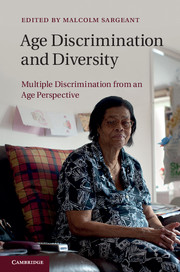Book contents
- Frontmatter
- Contents
- Figures
- Tables
- Contributors
- 1 Ageism and age discrimination
- 2 Multiple discrimination
- 3 Older women, work and the impact of discrimination
- 4 Still disadvantaged? Women in modern pension systems
- 5 Ageing and social class: towards a dynamic approach to class inequalities in old age
- 6 Age, sexual orientation and gender identity
- 7 Age and ethnicity
- 8 Disability and age discrimination
- 9 New approaches for understanding inequalities in service use among older people
- Index
- References
1 - Ageism and age discrimination
Published online by Cambridge University Press: 05 August 2011
- Frontmatter
- Contents
- Figures
- Tables
- Contributors
- 1 Ageism and age discrimination
- 2 Multiple discrimination
- 3 Older women, work and the impact of discrimination
- 4 Still disadvantaged? Women in modern pension systems
- 5 Ageing and social class: towards a dynamic approach to class inequalities in old age
- 6 Age, sexual orientation and gender identity
- 7 Age and ethnicity
- 8 Disability and age discrimination
- 9 New approaches for understanding inequalities in service use among older people
- Index
- References
Summary
Introduction
This book is about the diversity of older people and the discrimination that results. Older people are often stereotyped according to their age. Age stereotyping is concerned with associating certain characteristics, or the lack of them, with certain ages. It in effect homogenises the particular age group as being all the same, rather than recognising any diversity within that age group (Robinson, Gustafson and Popovich 2008). There is an impression that older people share certain attributes, patterns of behaviour, appearances and beliefs (Ward et al. 2008). This stereotyping according to age is not restricted to older people of course and can apply to all ages and age groups. Here is a useful quote that illustrates how the issue of age pervades many aspects of the life course:
Our lives are defined by ageing: the ages at which we can learn to drive, vote, have sex, buy a house, or retire, get a pension, travel by bus for free. More subtle are the implicit boundaries that curtail our lives: the ‘safe’ age to have children, the ‘experience’ needed to fill the boss’s role, the physical strength needed for some jobs. Society is continually making judgments about when you are too old for something – and when you are too old.
(Age Concern 2005)This book is concerned with the effect on older people of age discrimination and ageism and how age relates to other diverse characteristics to create the potential for multiple discrimination.
- Type
- Chapter
- Information
- Age Discrimination and DiversityMultiple Discrimination from an Age Perspective, pp. 1 - 15Publisher: Cambridge University PressPrint publication year: 2011
References
- 2
- Cited by

